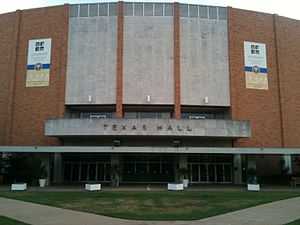Texas Hall

Texas Hall on the campus of the University of Texas at Arlington is a 76,000-square-foot (7,100 m2) combination theater and special events center. Seating capacity is 2,709 for stage productions and was 3,309 for athletic events.
Texas Hall hosts an average of 200-300 events per year. It hosts concerts, lectures, meetings, theater, and dance in its theater configuration.
From 2009 through 2011, Texas Hall was host to the Miss Texas pageant.[1]
The debut event at Texas Hall was a performance by legendary American jazz trumpeter and singer Louis Armstrong on Monday, October 18, 1965.
Some of the bigger names to appear at Texas Hall include Aerosmith, Maya Angelou, Prime Minister Benazir Bhutto, Pat Boone, Bowling for Soup, Harry Chapin, Neil Diamond, Everclear, Harlem Globetrotters, Houston Ballet, Earvin “Magic” Johnson, James Earl Jones, Judas Priest, Kansas, Kiss, Ludacris, Barry Manilow, Steve Miller Band, MTV Battle of the Bands, Willie Nelson, Leonard Nimoy, Edward James Olmos, Cal Ripkin, Jr., Bob Seger, Jerry Seinfeld, Emmitt Smith, The Supremes, Veggie Tales, Forest Whitaker, Johnny Winter and Frank Zappa. [2]
Texas Hall is still used for stage performances and the like, but the athletic events have moved to the newer venue.
Features
Texas Hall is a traditional stage-theater setting with stage side seating, balcony seating and lobbies outside both seating areas. Seating in the lower section is 1,357 while the balcony seats 1,352. Prior to the athletic teams vacating Texas Hall, there used to be bleacher seating opposite the theater seating that could sit 600. Both lobbies contain restroom and concession areas.[3]
The stage is over 5,000-square-foot (460 m2). Underneath the stage are the dressing rooms and contained the restrooms for the bleacher seating. A sound station with view of the stage is at the back of the floor seating.
Athletic Venue

Texas Hall debuted as a basketball facility on December 1, 1965 at a price of $1.7 million, where the then Arlington State College Rebels men's basketball team hosted the East Texas State Lions.[4] UTA lost the opener 67-61, but would maintain a home court advantage until the final game. UTA's record at Texas Hall is 351-222, a winning percentage of .613 percent. Despite only 15 winning seasons in the 47 UTA called Texas Hall home, UTA had a winning home record in 32 of those seasons.
As an athletic facility, Texas Hall was the home of UT Arlington Mavericks men's basketball, women's basketball, wheelchair basketball and volleyball. It is among the most unusual basketball/volleyball venues in America, since the court is located on the stage of Texas Hall. In 1997 Texas Hall was noted by Sports Illustrated as one of college basketball's best places to view a game. This is because of the up-close view the audience has of the court.
On February 12, 2009, UTA announced that the UT System Board of Regents approved the construction of a new arena on the campus called College Park Center. Construction started on the $78 million, 7,000-seat, 190,000-square-foot (18,000 m2) center in 2009, and the new arena opened in February 2012.
The final men's basketball game Texas Hall hosted was January 21, 2012 against the Stephen F Austin, in which the Mavs won 63-54. The final game was a women's contest held on January 28, 2012 against Texas State, a 90-73 setback.
References
- ↑ Walker, Patrick M. (June 26, 2012). "Miss Texas will don crown in Allen instead of Arlington". Fort Worth Star-Telegram (Fort Worth, TX). Retrieved July 6, 2012.
- ↑ http://www.uta.edu/texashall/speakers.php
- ↑ http://www.uta.edu/texashall/
- ↑ http://www.star-telegram.com/2012/01/20/3675888/texas-hall-makes-its-curtain-call.html
| |||||||||||||||||
Coordinates: 32°43′47″N 97°06′55″W / 32.7297°N 97.1154°W